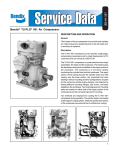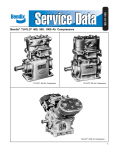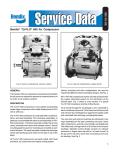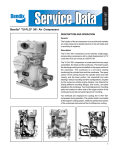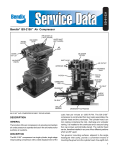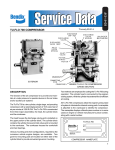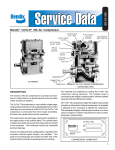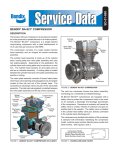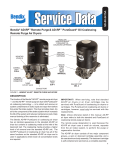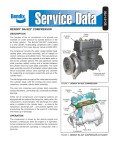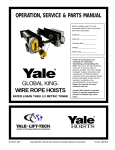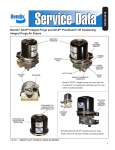Download BENDIX SD-01-326 User's Manual
Transcript
SD-01-326 ® Bendix® TU-FLO® 400, 500, 1000 Air Compressors TU-FLO® 400 Air Compressor TU-FLO® 500 Air Compressor TU-FLO® 1000 Air Compressor 1 DESCRIPTION AND OPERATION GENERAL The function of the air compressor is to build up and maintain the air pressure required to operate air powered devices in air brake or air auxiliary systems. and they have no external moving parts. Both air and water cooled type compressors are available. Various mounting and drive adaptations are used as required by different vehicle engine designs (Fig. 4). DESCRIPTION Tu-Flo® Type 400, 500, and 1000 compressors are single stage, reciprocating piston type compressors. Tu-Flo® 400 (Fig. 1) and 500 (Fig. 2) compressors have two cylinders while the Tu-Flo® 1000 compressor (Fig. 3) is a V-type design having four cylinders. The rated capacity of all Bendix compressors is their piston displacement in cubic feet per minute when operating at 1,250 RPM. The rated capacity of the Tu-Flo® 400 compressor is 7-1/4 cubic feet per minute. The Tu-Flo® 500 compressor is rated at 12 cubic feet per minute and the Tu-Flo® 1000 compressor has a rating of 24 cubic feet per minute. Tu-Flo® type compressors have automatic type inlet valves. Their unloading mechanisms are located in the cylinder block FIGURE 1 - TU-FLO® 400 AIR COMPRESSOR FIGURE 4 - VARIOUS COMPRESSOR MOUNTINGS Compressors are either engine or self-lubricated. The majority used are the engine lubricated types (Fig. 5) which obtain the oil necessary to lubricate their moving parts from the engines on which they are mounted. To meet the requirements of some manufacturers and for field installations, self-lubricated types (Fig. 6) are available. They are compressors having a self-contained oil supply and pumping system. FIGURE 2 - TU-FLO® 500 AIR COMPRESSOR FIGURE 3 - TU-FLO® 1000 AIR COMPRESSOR 2 The method of lubricating the moving parts of the compressor is the same in either type. Oil is forced through the oil passage in the crankshaft and out around each connecting rod journal. The turning motion of the crankshaft throws the oil that is forced out at the journals, against the cylinder bores and crankcase walls, lubricating the bores and crankshaft bearings. The wrist pins and wrist pin bushings are lubricated in two ways depending upon the type connecting rods used. Older design compressors had forged steel rifle-drilled rods through which oil was forced to the wrist pin bushings. Later versions OPERATION GENERAL FIGURE 5 ENGINE LUBRICATED TYPE FIGURE 6 SELF-LUBRICATED TYPE had either die cast aluminum, cast ductile iron, or forged steel rods which were not rifle drilled but were drilled at the top of the rod. The wrist pins and bushings are lubricated by oil dripping from a drip-boss on the piston into a “catch-funnel” at the top of the rod and through the drilled passage to the bushings and pins. (SEE FIG. 7) All compressors run continuously while the engine is running, but actual compression of air is controlled by a governor, which stops or starts the compression of air by loading or unloading the compressor in conjunction with its unloading mechanism. This is done when the air pressure in the system reaches the desired maximum or minimum pressures. TO RESERVOIR INLET VALVE UNLOADER PLUNGER DISCHARGE VALVE PISTON INTAKE STRAINER WRIST PIN BUSHING PISTON WRIST PIN LOCK WIRE TO GOVERNOR CAST IRON PISTON WRIST PIN STROKE INTAKE OIL PASSAGE STEEL CONNECTING ROD OLD DESIGN “CATCH FUNNEL” WRIST PIN BUSHING DIE CAST PISTON DIE CAST CONNECTING ROD NEW DESIGN FIGURE 7- PISTONS & CONNECTING RODS A nameplate is attached to the crankcase of all compressors. It shows the piece number, type and serial number (Fig. 8). A nameplate with a black background denotes a new compressor, whereas a nameplate with a red background designates that the compressor is a factory reconditioned unit. All compressors are identified by the piece number which is the number to use when reference is made to a particular compressor. The type and serial number is supplementary information. FIGURE 9 INTAKE AND COMPRESSION (Loaded) During the down stroke of the piston, a slight vacuum created above the piston causes the inlet valve to move off its seat. Atmospheric air is drawn in through the compressor intake, by the open inlet valve, and on top of the piston (Fig. 9). As the piston starts its upward stroke, the air that was drawn in on the down stroke is being compressed. Now, air pressure on top of the inlet valve plus the force of its spring, returns the inlet valve to its seat. The piston continues the upward stroke and compresses the air sufficiently to overcome the discharge valve spring and unseat the discharge valve. The compressed air then flows by the open discharge valve, into the discharge line and on to the reservoirs (Fig. 10). TO RESERVOIR INLET VALVE UNLOADER PLUNGER DISCHARGE VALVE INTAKE STRAINER PISTON TO GOVERNOR STROKE COMPRESSION FIGURE 8 - COMPRESSOR NAMEPLATE FIGURE 10 3 As the piston reaches the top of its stroke and starts down, the discharge valve spring returns the discharge valve to its seat. This prevents the compressed air in the discharge line from returning to the cylinder bore as the intake and compression cycle is repeated. NON-COMPRESSION (Unloaded) When the air pressure in the reservoir reaches the high pressure setting of the governor, the governor opens, allowing air to pass from the reservoir through the governor and into the cavity beneath the unloader pistons. This lifts the unloader pistons and plungers. The plungers move up and hold the inlet valves off their seats (Fig. 11). TO RESERVOIR INLET VALVE UNLOADER PLUNGER DISCHARGE VALVE PISTON INTAKE STRAINER TO GOVERNOR STROKE UNLOADING FIGURE 11 With the inlet valves held off their seats by the unloader pistons and plungers, air is merely pumped back and forth between the two cylinders. When air is used from the reservoir and the pressure drops to the low pressure setting of the governor, the governor closes, and in doing so, exhausts the air from beneath the unloader pistons. The unloader saddle spring forces the saddle, pistons and plungers down and the inlet valves return to their seats. Compression is then resumed. COMPRESSOR & THE AIR BRAKE SYSTEM GENERAL The compressor is part of the total air brake system, more specifically, the charging portion of the air brake system. As a component in the overall system its condition, duty cycle, proper installation and operation will directly affect other components in the system. Powered by the vehicle engine, the air compressor builds the air pressure for the air brake system. The air compressor is typically cooled by the engine coolant system, lubricated by the engine oil supply and has its inlet connected to the engine induction system. As the atmospheric air is compressed, all the water vapor originally in the air is carried along into the air system, as well as a small amount of the lubricating oil as vapor. If an air dryer is not used to remove these contaminants prior to 4 entering the air system, the majority, but not all, will condense in the reservoirs. The quantity of contaminants that reach the air system depends on several factors including installation, maintenance and contaminant handling devices in the system. These contaminants must either be eliminated prior to entering the air system or after they enter. DUTY CYCLE The duty cycle is the ratio of time the compressor spends building air to the total engine running time. Air compressors are designed to build air (run "loaded") up to 25% of the time. Higher duty cycles cause conditions that affect air brake charging system performance which may require additional maintenance. Factors that add to the duty cycle are: air suspension, additional air accessories, use of an undersized compressor, frequent stops, excessive leakage from fittings, connections, lines, chambers or valves, etc. Refer to Table A in the Troubleshooting section for a guide to various duty cycles and the consideration that must be given to maintenance of other components. COMPRESSOR INSTALLATION While the original compressor installation is usually completed by the vehicle manufacturer, conditions of operation and maintenance may require additional consideration. The following presents base guidelines. DISCHARGE LINE The discharge line allows the air, water-vapor and oil-vapor mixture to cool between the compressor and air dryer or reservoir. The typical size of a vehicle's discharge line, (see column 2 of Table A in the Troubleshooting section) assumes a compressor with a normal (less than 25%) duty cycle, operating in a temperate climate. See Bendix and/or other air dryer manufacturer guidelines as needed. The discharge line must maintain a constant slope down from the compressor to the air dryer inlet fitting or reservoir to avoid low points where ice may form and block the flow. If, instead, ice blockages occur at the air dryer or reservoir inlet, insulation may be added here, or if the inlet fitting is a typical 90 degree fitting, it may be changed to a straight or 45 degree fitting. Shorter discharge line lengths or insulation may be required in cold climates. While not all compressors and charging systems are equipped with a discharge line safety valve this component is recommended. The discharge line safety valve is installed in the cylinder head or close to the compressor discharge port and protects against over pressurizing the compressor in the event of a discharge line freezeup. DISCHARGE LINE TEMPERATURE When the temperature of the compressed air that enters the air dryer is within the normal range, the air dryer can remove most of the charging system oil. If the temperature of the compressed air is above the normal range, oil as oilvapor is able to pass through the air dryer and into the air system. Larger diameter discharge lines and/or longer discharge line lengths can help reduce the temperature. The Air Brake Charging System supplies the Discharge Line Optional “Ping” Tank Air Dryer compressed air for the braking system as well as other air accessories for the vehicle. The system usually consists of an air compressor, governor, discharge line, air dryer, and service reservoir. Optional Bendix® PuraGuard ® QC™ Oil Coalescing Filter Compressor Governor (Governor plus Synchro valve for the Bendix® DuraFlo™ 596 Compressor) Service Reservoir (Supply Reservoir) Reservoir Drain FIGURE 12A - SYSTEM DRAWING PREVENTIVE MAINTENANCE HOLE THREAD Regularly scheduled maintenance is the single most important factor in maintaining the air brake charging system. Refer to Table A in the Troubleshooting section for a guide to various considerations that must be given to the maintenance of the compressor and other related charging system components. If the compressor is a self-lubricated type, its oil level should be checked daily. The oil level should be kept between the bottom of the dipstick threads and the bottom of the dipstick (Fig. 13). Every 8,000 miles or 300 operating hours, the oil should be drained and refilled with SAE 10-20-30. FIGURE 12B - DISCHARGE LINE SAFETY VALVE The air dryer contains a filter that collects oil droplets, and a desiccant bed that removes almost all of the remaining water vapor. The compressed air is then passed to the air brake service (supply) reservoir. The oil droplets and the water collected are automatically purged when the governor reaches its "cut-out" setting. For vehicles with accessories that are sensitive to small amounts of oil, we recommend installation of a Bendix® PuraGuard® QC™ oil coalescing filter, designed to minimize the amount of oil present. COOLING Tu-Flo® 400, 500 or 1000 compressors may be air-cooled or water- cooled and in some instances will have air-cooled blocks and water-cooled heads. The air-cooled versions are easily recognized by the external fins. The water-cooled versions are cooled by vehicle coolant. FIGURE 13 - OIL LEVEL - SELF-LUBRICATED COMPRESSOR POLYURETHANE SPONGE STRAINER (Fig. 14) Remove and wash all of the parts. The strainer element should be cleaned or replaced. If the element is cleaned, it should be washed in a commercial solvent or a detergent and water solution. The element should be saturated in clean engine oil, then squeezed dry before replacing it in the strainer. Be sure to replace the air strainer gasket if the entire air strainer is removed from the compressor intake. 5 FIGURE 16 - COMPRESSOR INTAKE ADAPTER FIGURE 14 - POLYURETHANE SPONGE STRAINER AIR LEAKAGE TESTS Leakage past the discharge valves can be detected by removing the discharge line, applying shop air back through the discharge port and listening for escaping air. Also the discharge valves and the unloader pistons can be checked for leakage by building up the air system until the governor cuts out, then stopping the engine. With the engine stopped, carefully listen for escaping air at the intake. To pinpoint leakage if noted, squirt oil around the unloader pistons. If there is no noticeable leakage at the unloader pistons, the discharge valves may be leaking. FIGURE 15 - DRY ELEMENT- PLEATED PAPER AIR STRAINER DRY ELEMENT - PLEATED PAPER AIR STRAINER (FIG. 15) Remove the spring clips from either side of mounting baffle and remove the cover. Replace the pleated paper filter and remount the cleaned cover making sure the filter is in position. Be sure to replace the air strainer gasket if the entire air strainer is removed from the compressor intake. (NOTE: Some compressors are fitted with compressor intake adapters (Fig. 16) which allow the compressor intake to be connected to the engine air cleaner.) In this case, the compressor receives a supply of clean air from the engine air cleaner. When the engine air filter is changed, the compressor intake adapter should be checked. If it is loose, remove the intake adapter, clean the strainer plate, if applicable, and replace the intake adapter gasket, and reinstall the adapter securely. Check line connections both at the compressor intake adapter and at the engine air cleaner. Inspect the connecting line for ruptures and replace it if necessary. 6 If the compressor does not function as described above, or leakage is excessive, it is recommended that it be returned to the nearest Bendix authorized distributor for a factory rebuilt compressor under the repair exchange plan. If this is not possible, the compressor can be repaired with genuine Bendix parts, in which case the following information should prove helpful. REMOVING AND INSTALLING REMOVING These instructions are general and in some cases additional precautions must be taken. Drain air brake system. If water-cooled type compressor, drain engine cooling system, compressor cylinder head and block. Disconnect all air lines, water and oil lines to and from compressor. Remove compressor mounting bolts and compressor from engine. Use a gear-puller to remove the gear or pulley from compressor crankshaft. INSTALLATION ENGINE-LUBRICATED TYPES Clean oil supply line. Before connecting this line to the compressor, run the engine briefly to be sure oil is flowing freely through the supply line. Clean the oil return line or return passages through the brackets; these passages must be unrestricted so oil can return to the engine. Prelubricate compressor cylinder walls and bearings with clean engine oil before assembling compressor. Always use a new mounting gasket and be sure oil hole in gasket and compressor is properly aligned with oil supply line. SELF-LUBRICATED TYPES Fill compressor crankcase with clean engine oil before operating compressor. Refer to “Tabulated Data” section for proper amount. ALL TYPES Inspect pulley or gear and associated parts for wear or damage. They must be a neat fit on compressor crankshaft. Replace pulley or gear if worn or damaged. Install pulley or gear on compressor crankshaft making sure it properly contacts the shaft and does not ride the key. Tighten crankshaft nut to 65-70 ft. lbs. and install cotter pin. Be sure the air cleaner is clean and properly installed. If the compressor intake is connected to either the engine air cleaner or supercharger, these connections must be tight with no leakage. Clean or replace any damaged or dirty air or water lines which may be corroded, before connecting them to the compressor. Use a new discharge fitting gasket. Align compressor drive and adjust proper belt tension. Tighten mounting bolts securely and evenly. After installation, run compressor and check for air, oil, or water leaks at compressor connections. Also check for noisy operation. Check the exterior of the compressor for the presence of oil seepage and refer to the TROUBLESHOOTING section for appropriate tests and corrective action. OIL PASSING All reciprocating compressors currently manufactured will pass a minimal amount of oil. Air dryers will remove the majority of oil prior to entrance into the air brake system. For particularly oil sensitive systems the Bendix® PuraGuard® QC™ oil coalescing filter can be used in conjunction with a Bendix air dryer. If compressor oil passing is suspected, refer to the TROUBLESHOOTING section and TABLE A for the symptoms and corrective action to be taken. In addition, Bendix has developed the "Bendix Air System Inspection Cup" or BASIC test to help substantiate suspected excessive oil passing. The steps to be followed when using the BASIC test are presented in APPENDIX A at the end of the TROUBLESHOOTING section. Drain the engine cooling system and the cylinder head of the compressor. Disconnect all air, water and oil lines leading to and from the compressor. Remove the drive gear(s) or pulley from the compressor crankshaft using a gear puller. Inspect the pulley or gear and associated parts for visible wear or damage. Since these parts are precision fitted, they must be replaced if they are worn or damaged. DISASSEMBLY GENERAL Remove road dirt and grease from the exterior of the compressor with a cleaning solvent. Before the compressor is disassembled, the following items should be marked to show their relationship when the compressor is assembled. Mark both the front and rear end cover in relation to the crankcase. Mark the drive end of the crankshaft in relation to the front end cover and the crankcase. Mark the cylinder head in relation to the block and block to crankcase. Mark the base plate or base adapter in relation to the crankcase. A convenient method to indicate the above relationships is to use a metal scribe to mark the parts with numbers or lines. Do not use a marking method that can be wiped off or obliterated during rebuilding, such as chalk. Remove all compressor attachments such as governors, air strainers or inlet fittings, discharge fittings and pipe plugs. CYLINDER HEAD Remove the cylinder head cap screws and tap the head with a soft mallet to break the gasket seal. Remove the inlet valve springs form the head and inlet valves from their guides in the block. Remove inlet valve guides from around the inlet valve seats on the block, taking care not to damage seats. Scrape off any gasket material from the cylinder head and block. Unscrew the discharge cap nuts from the head and remove the discharge valves and springs. Inspect the discharge valve seats for nicks, cracks, and excessive wear and remove and replace if necessary. The discharge valve cap nuts should be inspected for wear and replaced if excessive peening has occurred. To determine if excessive peening has occurred, measure the discharge valve travel. Discharge valve travel must not exceed .056 in. for the Tu-Flo® 400 compressor and .046 in. for the Tu-Flo® 500 and 1000 compressors. CRANKCASE BASE PLATE OR ADAPTER Remove the cap screws securing the base plate or base adapter. Tap with soft mallet to break the gasket seal. Scrape off any gasket material from crankcase and plate or adapter. REMOVING AND DISASSEMBLY CONNECTING ROD ASSEMBLIES REMOVING (NOTE: Before removing the connecting rods, mark each connecting rod and its cap. Each connecting rod is matched to its own cap for proper bearing fit, and these parts must not be interchanged.) These instructions are general and are intended to be a guide. In some cases additional preparations and precautions are necessary. Chock the wheels of the vehicle and drain the air pressure from all the reservoirs in the system. 7 FIGURE 17 - TU-FLO® 400 AIR COMPRESSOR VERTICAL MOUNT - ENGINE LUBRICATED Straighten the prongs of the connecting rod bolt lock strap and remove the bolts and bearing caps. Push the piston with the connecting rods attached out the top of the cylinders of the crankcase. Replace the bearing caps on their respective connecting rods. Remove the piston rings from the pistons. If the pistons are to be removed from the connecting rods, remove the wrist pin lock wires or teflon plugs and press the wrist pins from the pistons and connecting rods. If the pistons are removed from the rod, inspect the bronze wrist pin bushing. Press out and replace the bushing if it is excessively worn. (See Inspection of Parts.) Discard the piston rings and the connecting rod journal bearings. Discard the wrist pin bushings if they were removed. New Tu-Flo® 400 compressors manufactured after approximately September 1977 will have connecting rods without bearing inserts. Repair size rods will have inserts. REMOVING AND DISASSEMBLING BASE PLATE SELF-LUBRICATED TYPE COMPRESSORS (Fig. 18) Remove screws that hold base plate. Remove base plate. Remove oil relief valve set screw, then oil relief valve. Remove oil strainer retaining ring and lift out oil strainer. Unless it is necessary, the oil pump piston bushing should not be removed. If necessary, remove the bushing set screw, then bushing and shim. 8 FIGURE 18 - BASE PLATE SELF-LUBRICATED TYPE COMPRESSOR Remove cotter pin from oil rod cap nuts, remove nuts, oil pump piston rod and cap. CRANKCASE (Fig. 19) Remove end cover with oil seal, remove end cover gasket. Replace oil seal after cleaning end cover. Remove cap screws that hold opposite end cover to crankcase; remove end cover and its gasket. Some compressors have crankcases that have a shoulder for positioning the crankshaft. In these cases the crankshaft must be removed through one particular end. Press the crankshaft and ball bearings from the crankcase, then press ball bearings from crankshaft. Many compressors will have sleeve-type bearings in the crankcase or in the end cover. If the clearance between crankshaft journal and bearing exceeds .0065 in. the sleeve bearing should be replaced with appropriate undersize. CLEANING AND INSPECTION OF PARTS CLEANING All parts should be cleaned thoroughly in a good cleaning solvent before inspection. CYLINDER HEAD ASSEMBLY Remove all carbon deposits from discharge cavities and all rust and scale from cooling cavities of cylinder head body. Scrape all foreign matter from body surfaces and use air pressure to blow dirt particles from all cavities. Discharge valves can be dressed by lapping them on a piece of fine crocus cloth on a flat surface, provided they are not excessively worn. FIGURE 19 - CRANKCASE - TU-FLO® 400 & 500 AIR COMPRESSORS CYLINDER BLOCK Clean carbon and dirt from inlet and unloader passages. Use air pressure to blow carbon and dirt deposits from unloader passages. Inlet valves, as in the case of discharge valves, not worn excessively, can be cleaned by lapping them on a piece of fine crocus cloth on a flat surface. OIL PASSAGE FIGURE 19A - CRANKCASE - TU-FLO® 1000 AIR COMPRESSOR BLOCK (Fig. 20) If compressor is fitted with an air strainer, inlet elbow or governor, remove same. Remove cap screws securing cylinder block to crankcase; separate crankcase and cylinder block and scrape off gasket. Remove unloader spring, spring saddle and spring seat from cylinder block. Remove unloader guides and plungers and, with the use of shop air, blow unloader pistons out of cylinder block unloader piston bores. Remove inlet valve guides; inlet valve seats can be removed but only if they are worn or damaged and are being replaced. Unloader bore bushings should be inspected but not removed unless they are damaged. Clean thoroughly all oil passages through crankshaft, connecting rods, crankcase, end covers and base plate. If necessary, inspect passages with a wire and blow foreign matter out with air pressure. CRANKCASE - SELF-LUBRICATED TYPE The breather should be thoroughly washed and cleaned. The oil pump check valve in the base should be removed and replaced. It is important when the oil pump check valve is replaced that it be installed correctly with the ball stop pin end pressed in first. When installed, the ball and its seat should be visible from the crankcase base. INSPECTION OF PARTS CYLINDER HEAD BODY Inspect cylinder head body for cracks or damage. WATER-COO LED TYPE Use air pressure to test water jackets of cylinder head and block for leakage. Replace unit if leakage is found. DISCHARGE VALVES AND SEATS If discharge valves are worn and grooved where they contact the seats, they should be replaced. If the discharge valve seats are worn excessively so that there is no longer enough metal left to reclaim them by lapping, the seats should be replaced. DISCHARGE VALVE SPRING AND CAP NUTS Replace all used discharge valve springs and cap nuts. FIGURE 20 - CYLINDER BLOCK - EXPLODED VIEW 9 CRANKCASE AND END COVERS Check for cracks or broken lugs in crankcase and end covers. Also check their oil passages to make sure they are open and clean. If an oil seal ring is used in the end cover, check fit of ring in ring groove. There should be 0.008 in. to 0.015 in. clearance at the gap when placed in the end bore of the crankshaft. If the oil ring is worn thin or is damaged, it should be replaced. Inspect oil ring groove in end cover; if groove is worn excessively replace end cover or machine groove for next oversize oil seal ring. If the crankshaft main bearings are installed in the end cover, check for excessive wear and flat spots and replace if necessary. CYLINDER BLOCK Check for cracks or broken lugs on cylinder block. Also check unloader bore bushings to be sure they are not worn, rusted or damaged. If these bushings are to be replaced they can be removed by running a 1/8 in. pipe thread tap inside the bushing, then inserting a 1/8 in. pipe threaded rod and pulling the bushing straight up and out. Do not use an easy-out for removing these bushings. INLET VALVES AND SEATS If inlet valves are grooved or worn where they contact the seat, they should be replaced. If the inlet valve seats are worn or damaged so they cannot be reclaimed by facing, they should be replaced. CYLINDER BORES Cylinder bores which are scored or out of round by more than 0.002 in. or tapered more than 0.003 in. should be rebored or honed oversize. Oversize pistons are available in 0.010, 0.020, and 0.030 oversizes. Cylinder bores must be smooth, straight and round. Clearance between cast iron pistons and cylinder bores should be between 0.002 in. minimum and 0.004 in. maximum (Fig. 21). PISTONS Check pistons for scores, cracks or enlarged ring grooves; replace pistons if any of these conditions are found. Measure each piston with a micrometer in relation to the cylinder bore diameter to be sure the clearance is between 0.002 in. minimum and 0.004 in. maximum. Check fit of wrist pins on pistons and connecting rod bushings. Wrist pin should be a light press fit in pistons. If wrist pin is loose fit, the pin, piston, or both should be replaced. Check fit of wrist pin in connecting rod bushing by rocking the piston. This clearance should not exceed 0.0015 in. Replace wrist pin bushings if excessive clearance is found. Wrist pin bushings should be reamed after being pressed into connecting rods. Replace used wrist pin lock wires. Tu-Flo® 400 compressors manufactured after September 1977 will have Teflon plugs in each end of the wrist pins instead of the lock wire. The Teflon plugs (pc. no. 292392) may be used instead of the lock wires on all compressors. See Fig. 22. PISTON RINGS Check fit of piston rings in piston ring grooves. Check ring gap with rings installed in cylinder bores. Refer to Fig. 24 for correct gap and groove clearance. All rings must be located in their proper ring grooves as shown. The rings can be identified by the width and should be installed with the bevel or the pipmark (if any) toward the top of the piston. This applies to cast iron pistons (only as shown above). Die cast pistons use five (5) narrow rings. COMPRESSION RINGS (2) COMPRESSION RINGS (2) FIGURE 22 - TU-FLO® 400 AIR COMPRESSOR NEW STYLE FIGURE 21 - MEASURING CYLINDER BORES 10 TU-FLO® 400 AIR COMPRESSOR CORRECT GROOVE CLEARANCE Used unloader mechanism should be replaced by unloader kits 265014 for Type Tu-Flo® 400 compressors and 265015 for Types Tu-Flo® 500 and 1000 compressors. The Tu-Flo® 1000 compressor requires two kits per compressor. .0015” .0030” The new unloader pistons should be a loose sliding fit in the unloader piston bores of the cylinder block. CORRECT GAP CLEARANCE WITH RING IN CYLINDER PARTS SPECIAL TO SELF-LUBRICATED TYPE COMPRESSORS .0035” .014” FIGURE 23 - TU-FLO® 400 AIR COMPRESSOR OLD STYLE TU-FLO® 500 & 1000 AIR COMPRESSOR CORRECT GROOVE CLEARANCE NARROW WIDE .0035” .0035” .002” .004” OIL PUMP SCREEN Check oil pump screen to be sure it is clean and not damaged; replace if damaged. OIL PUMP PISTON AND BUSHING Check fit of oil pump piston in base plate pump bushing. It must be a medium sliding fit. If excessive clearance is found, the oil rod and/or bushing must be replaced. OIL PUMP RELIEF VALVE CORRECT GAP CLEARANCE WITH RING IN CYLINDER .0035” .014” UNLOADER MECHANISM If the oil pump relief valve is defective, it should be replaced. NARROW WIDE FIGURE 24 - PISTON RING POSITIONS - GAPS AND GROOVE CLEARANCE OIL PUMP CHECK VALVE The check valve should be replaced. It can be checked by applying air pressure back through the pin stop end and noting that the ball check seals on its seat. REPAIRS CRANKSHAFT DISCHARGE VALVES AND SEATS Check crankshaft screw threads, keyways, tapered ends and all machined and ground surfaces for wear, scores, or damage. Crankshaft journals which are out of round more than 0.001 in. must be reground. Bearing inserts are available in 0.010 in., 0.020 in., and 0.030 in. undersizes for reground crankshafts. Main bearing journals must be maintained so bearings are snug fit. The oil seal ring groove or grooves in crankshafts fitted with oil seal rings must not be worn. The ring groove walls must have a good finish and they must be square. Check to be sure the oil passages are open and clean through the crankshaft. If discharge valve seats merely show signs of slight wear, they can be dressed by using a lapping stone, grinding compound and grinding tool. Install new discharge valves and valve springs. CONNECTING ROD BEARINGS Check connecting rod bearings on crankshaft journals for proper fit. Used bearing inserts should be replaced. Connecting rod caps are not interchangeable. The locking slots of the connecting rod and cap should be positioned adjacent to each other. Clearance between the connecting rod journal and the connecting rod bearing must not be less than 0.0003 in. or more than 0.0021 in. after rebuilding. MAIN BEARINGS Check for wear or flat spots; if found, bearings should be replaced. If type with sleeve bearing, this bearing should be checked for scores and wear and replaced if necessary. To test for leakage by the discharge valves, apply about 100 pounds of air pressure through the cylinder head discharge port and apply soap suds at the discharge valves and seats. Leakage which will permit the formation of bubbles is permissible. If excessive leakage is found, leave the air pressure applied, and with the use of a fibre or hardwood dowel and hammer, tap the discharge valves off their seats several times. This will help the valves to seat and should reduce any leakage. With the air pressure still applied at the discharge port of the cylinder head, check for leakage at the discharge valve cap nuts. No leakage is permissible. INLET VALVES AND SEATS If inlet valve seats show sign of slight nicks or scratches, they can be redressed with a fine piece of emery cloth or by lapping with a lapping stone, grinding compound and grinding tool. If the seats are excessively damaged to the extent that they cannot be reclaimed, they should be replaced. The dimension from the top of the cylinder block to the inlet valve seat should not exceed 0.118 in. nor be less than 0.101 in. 11 Slightly worn or scratched inlet valves can be reclaimed by lapping them on a piece of fine crocus cloth on a flat surface, but it is suggested that new inlet valves be installed. ASSEMBLY INSTALLING CYLINDER BLOCK Position cylinder block gasket and block on crankcase according to markings made prior to disassembly. Using cap screws with lock washers, secure cylinder block to crankcase. Remove connecting bolts and bearing cap from one connecting rod. Turn crankshaft so one of its connecting rod journals is in the downward, center position. Compress the rings with a ring compression tool and insert the connecting rod with piston through the top of the cylinder whose journal is down. Position and attach the bearing cap to the connecting rod, making sure the bolt lock washers are properly positioned on the cap. Tighten connecting rod bolts evenly and bend the two new lock washer prongs up against the hex head of the bolt. Install the other connecting rod and piston in the same manner. INSTALLING CRANKSHAFT If the crankshaft is fitted with oil seal rings, install rings. Position ball bearings and crankshaft in crankcase, making sure the drive end of the crankshaft is positioned as marked before disassembly. If one end of the crankcase is counterbored for holding a bearing, be sure the crankshaft is installed through the correct end of the crankcase. Carefully press crankshaft and bearings into crankcase using arbor press. Position a new rear end cover gasket, when used, over the rear end of the crankcase, making sure the oil hole in the gasket lines up with the oil hole in the crankcase. Position end cover with oil seal ring, if used, installed over crankcase and end cover gasket. The end cover should be positioned correctly in relation to the oil holes in the gasket and crankcase. Secure end cover to crankcase with cap screws and lock washers. If the opposite end cover requires an oil seal which was removed on disassembly, a new seal should be pressed into end cover. Position new end cover gasket and carefully install end cover over crankshaft and to crankcase, avoiding damage to the seal. Secure end cover with cap screw and lock washers. PISTONS AND CONNECTING RODS If new wrist pin bushings are to be used, they should be pressed into the connecting rods so that the oil hole in the bushing lines up with the one in the rod. The new bushings should then be reamed or honed to provide between 0.0002 in and 0.0007 in. clearance on the wrist pin. Position connecting rod in piston and press in wrist pin so that lockwire hole in the pin aligns with that of the piston. Install new lockwire through piston and wrist pin and lock same by snapping short end into lockwire hole at the bottom of the piston (Fig. 7). Teflon plugs in wrist pin ends may be used instead of the lockwires (Fig. 22). Install piston rings in correct location with ring pipmarks up (Fig. 24). Stagger the position of the ring gaps. Prelubricate piston, piston rings, wrist pin and connecting rod bearings with clean engine oil before installing them in the compressor. 12 FIGURE 25 - UNLOADER MECHANISM UNLOADER MECHANISM (Fig. 25) The unloader pistons and their bores must be lubricated with special lubricant piece number 239379 (dimethyl polysiloxane) prior to installation. If new unloader kits are being installed, the pistons in the kit are already lubricated. Install the unloader pistons in their bores with caution against cutting the grommets or distorting the back-up rings. Position unloader plungers in their guides and slip them in and over the tops of the pistons. Install the unloader spring seat in the cylinder block; a small hole is drilled in the block for this purpose. Position the saddle between unloader piston guides so its forks are centered on the guides. Install the unloader spring, making sure it seats over the spring seats both in the block and on the saddle. Install inlet valve seats if they have been previously removed. Position and install inlet valve guides, then drop inlet valves in their guides. There should be a loose sliding fit between guides and valves. CYLINDER HEAD ASSEMBLY If previously removed, the discharge valve seats should be installed. Drop discharge valves into their seats. Install discharge valve springs and cap nuts. Place the inlet valve springs in the cylinder head. Use a small quantity of grease to hold them in place, just enough grease to keep the springs from falling out. Place cylinder head gasket on cylinder block. Carefully align cylinder head assembly on block and install cap screws with lock washers. Tighten securely and evenly cap screws that hold cylinder head to block. BASEPLATE TESTING REBUILT COMPRESSOR SELF-LUBRICATED TYPE COMPRESSORS Install oil pump piston and rod on crankshaft. In order to properly test a compressor under operating conditions, a test rack for correct mounting, cooling, lubricating and driving the compressor is necessary. Such tests are not compulsory if the unit has been carefully rebuilt by an experienced person. Oil rod bearing fit must be the same as specified for connecting rod bearings. Install oil rod cap nuts and cotter pins to lock oil rod nuts. Install oil pump relief valve in base plate. The relief valve can be tested at this stage by applying air pressure to the relief valve. The valve should open when the pressure is between 14 psi minimum and 24 psi maximum. When the relief valve is properly installed in the base plate, install set screw that locks it in place. Place oil pump screen in base and install retaining ring, making sure it snaps in place and secures the screw. Install oil filter fitting on base plate in its proper place. Install blanking cover on opposite oil filter fitting hole in plate. Install a new oil seal gasket around oil pump - check valve and position a new base plate gasket on the crankcase. Position base plate assembly on crankcase, making sure oil pump piston engages the oil pump bushing in the base plate. Install and tighten base plate screws. A compressor efficiency or build-up test can be run which is not too difficult. Before the test, the crankcase of a selflubricated type compressor should be properly filled with lubricating oil. An engine lubricated compressor must be connected to an oil supply line of at least 15 pounds pressure during the test and an oil return line must be installed to keep the crankcase drained. The compressor (when tested) should be tested without a strainer. To the discharge port of the compressor, connect a reservoir or reservoirs whose volume plus the volume of the connecting line equals 1,300 cubic inches. Run the compressor between 1,700 and 1,750 RPM. Elapsed time that the compressor takes to build up from 0 to 100 psi depends on the type compressor as follows: BUILD-UP TIME TYPE COMPRESSOR TU-FLO® 400 TU-FLO® 500 TU-FLO® 1000 0 TO 100 PSI 47 SECONDS MAXIMUM 30 SECONDS MAXIMUM 15 SECONDS MAXIMUM During the above test the compressor should be checked for oil leakage and noisy operation. COMPRESSOR TROUBLESHOOTING FIGURE 26 - AIR STRAINER - EXPLODED VIEW AIR STRAINER If the compressor is type with air strainer, assemble strainer (Fig. 26). Using a new strainer gasket, install strainer on cylinder block. IMPORTANT: The troubleshooting contained in this section considers the compressor as an integrated component of the overall air brake charging system and assumes that an air dryer is in use. The troubleshooting presented will cover not only the compressor itself, but also other charging system devices as they relate to the compressor. GOVERNOR If compressor is type with pad mounted governor, install a new or factory rebuilt governor using a new governor gasket. INSPECTION OF REBUILT UNIT Check to be sure that covers, plugs or masking tape are used to protect all ports if compressor is not to be installed immediately. Fit the end of all crankshafts with keys, nuts and cotter pins as required and then protect the ends against damage by wrapping with masking or friction tape. The open bottom of engine lubricated compressors should be protected against the entrance of dirt during handling or storage, by installing a temporary cover over base. WARNING! PLEASE READ AND FOLLOW THESE INSTRUCTIONS TO AVOID PERSONAL INJURY OR DEATH: When working on or around a vehicle, the following general precautions should be observed at all times. 1. Park the vehicle on a level surface, apply the parking brakes, and always block the wheels. Always wear safety glasses. 2. Stop the engine and remove ignition key when working under or around the vehicle. When working in the engine compartment, the engine should be shut off and the ignition key should be removed. Where circumstances require that the engine be in operation, EXTREME CAUTION should be used to prevent personal injury resulting from contact with moving, rotating, leaking, heated or electrically charged components. 13 3. Do not attempt to install, remove, disassemble or assemble a component until you have read and thoroughly understand the recommended procedures. Use only the proper tools and observe all precautions pertaining to use of those tools. 4. If the work is being performed on the vehicle’s air brake system, or any auxiliary pressurized air systems, make certain to drain the air pressure from all reservoirs before beginning ANY work on the vehicle. If the vehicle is equipped with an ADIS™ air dryer system or a dryer reservoir module, be sure to drain the purge reservoir. 5. Following the vehicle manufacturer’s recommended procedures, deactivate the electrical system in a manner that safely removes all electrical power from the vehicle. 6. Never exceed manufacturer’s recommended pressures. 7. Never connect or disconnect a hose or line containing pressure; it may whip. Never remove a component or plug unless you are certain all system pressure has been depleted. 14 8. Use only genuine Bendix® replacement parts, components and kits. Replacement hardware, tubing, hose, fittings, etc. must be of equivalent size, type and strength as original equipment and be designed specifically for such applications and systems. 9. Components with stripped threads or damaged parts should be replaced rather than repaired. Do not attempt repairs requiring machining or welding unless specifically stated and approved by the vehicle and component manufacturer. 10. Prior to returning the vehicle to service, make certain all components and systems are restored to their proper operating condition. 11. For vehicles with Antilock Traction Control (ATC), the ATC function must be disabled (ATC indicator lamp should be ON) prior to performing any vehicle maintenance where one or more wheels on a drive axle are lifted off the ground and moving. MAINTENANCE INSTRUCTIONS FOR LARGE SUMP TU-FLO® 1000 AIR COMPRESSOR 288578 (SPECIAL APPLICATION) This compressor is an air-cooled, belt driven, self lubricated, V-four cylinder compressor. It is driven by an electric motor and cooling air is supplied by a fan on the driven pulley. The system air pressure is controlled between 135 psi and 150 psi by a pressure switch starting and stopping the electric motor. INSTALLATION The base mounted compressor should be securely bolted down with 1/2" grade five or better cap screws torqued to 70 ft. pounds, making sure that motor and compressor pulleys are aligned and belt tension is correct. The crankcase should be filled with five quarts (4.7 liter) of SAE 20 W engine oil. The compressor must always be installed to rotate clockwise when viewed from the pulley end. The oil pump will not function if rotation is not correct. SCHEDULED MAINTENANCE NOTE: When checking or adding oil or servicing the crankcase breather, care should be taken to prevent dirt or foreign material from entering the breather or oil sump. Every 7,500 miles or seven weeks, whichever occurs first: Check oil level - replenish to top of filler plug opening. Replace both air cleaner filter elements and clean covers. Check belts and replace if broken, damaged or missing. Every 15,000 miles or 14 weeks, whichever occurs first: Remove crankcase ventilator, clean ports and replace with freshly oiled curled hair. Every 22,500 miles or 21 weeks, whichever occurs first: Drain oil and refill with fresh SAE 20 W engine oil. Inspect all bolts, fittings and plugs to ensure that all are tight. TABULATED DATA Number Cylinders Bore Size Stroke Displacement at 1,250 RPM Maximum recommended RPM Minimum coolant flow at maximum RPM Approximate horsepower required at 1,250 RPM Maximum inlet air temperature Maximum discharge air temperature Minimum pressure required to unload Minimum oil pressure required at engine idling speed Minimum oil pressure required at maximum governed engine speed Approximate average weight Oil capacity of self-lubricated model Minimum discharge line size Minimum coolant line size Minimum oil supply line size Minimum oil return line size **Minimum air inlet line size TU-FLO® 400 Air Compressor 2 2.0625" 1.5" 7.25 cu. ft./min. 3,000 water cooled 2,400 air cooled 2.5 gal./min. water cooled 250 CFM air flow TU-FLO® 500 Air Compressor 2 2.5" 1.6875" 12 cu. ft./min. 3,000 water cooled 2,400 air cooled 2.5 gal./min. water cooled 250 CFM air flow TU-FLO® 1000 Air Compressor 4 2.5" 1.6875" 24 cu. ft./min. 3,000 water cooled 2,400 air cooled 2.5 gal./ min. water cooled 250 CFM air flow 1.2 H.P. 250° F. 400° F. 2.3 H.P. 250° F. 400° F. 4.6 H.P. 250° F. 400° F. 60 PSI 60 PSI 60 PSI 5 PSI 5 PSI 5 PSI 15 PSI 34 lbs. .53 qts. 1/2" O.D. tubing or equivalent 15 PSI 46 lbs. .53 qts. 5/8" O.D. tubing or equivalent 3/8" O.D. tubing or equivalent 1/4" O.D. tubing or equivalent 1/2" O.D. tubing or equivalent 5/8" I.D. 1/2" O.D. tubing or equivalent 1/4" O.D. tubing or equivalent 5/8" O.D. tubing or equivalent 5/8" I.D. 15 PSI 75 lbs. .95 qts. to 5 qts.* 5/8" O.D. tubing or equivalent from each head to a common manifold with 1" tubing from manifold. 1/2" O.D. tubing or equivalent 1/4" O.D. tubing or equivalent 5/8" O.D. tubing or equivalent 1" I.D. if equipped with inlet manifold; or, dual 5/8" I.D. lines from engine to compressor inlets. *Part Number dictates oil capacity **Inlet line sizes specified for compressors with inlet connected to engine manifold. 15 40 BW1420 © 2004 Bendix Commercial Vehicle Systems LLC All rights reserved. 10/2004 Printed in U.S.A.
















